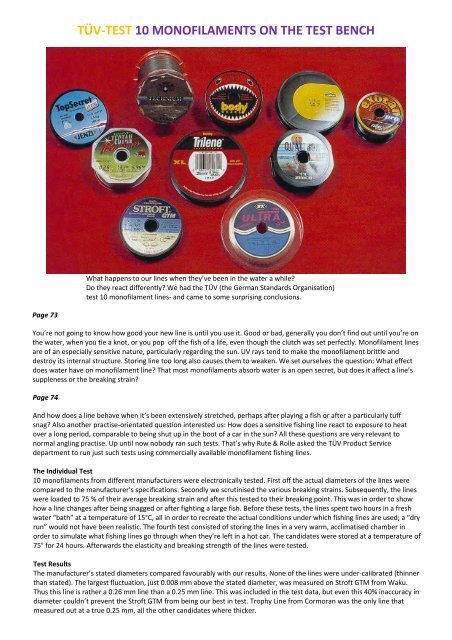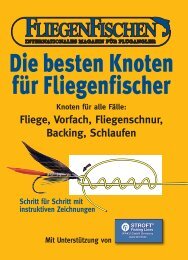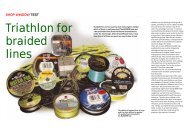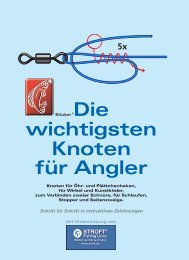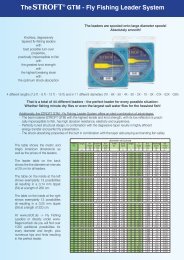tüv-test 10 monofilaments on the test bench - STROFT Fishing Lines
tüv-test 10 monofilaments on the test bench - STROFT Fishing Lines
tüv-test 10 monofilaments on the test bench - STROFT Fishing Lines
You also want an ePaper? Increase the reach of your titles
YUMPU automatically turns print PDFs into web optimized ePapers that Google loves.
Page 73<br />
TÜV‐TEST <str<strong>on</strong>g>10</str<strong>on</strong>g> MONOFILAMENTS ON THE TEST BENCH<br />
What happens to our lines when <strong>the</strong>y’ve been in <strong>the</strong> water a while?<br />
Do <strong>the</strong>y react differently? We had <strong>the</strong> TÜV (<strong>the</strong> German Standards Organisati<strong>on</strong>)<br />
<str<strong>on</strong>g>test</str<strong>on</strong>g> <str<strong>on</strong>g>10</str<strong>on</strong>g> m<strong>on</strong>ofilament lines‐ and came to some surprising c<strong>on</strong>clusi<strong>on</strong>s.<br />
You’re not going to know how good your new line is until you use it. Good or bad, generally you d<strong>on</strong>’t find out until you’re <strong>on</strong><br />
<strong>the</strong> water, when you tie a knot, or you pop off <strong>the</strong> fish of a life, even though <strong>the</strong> clutch was set perfectly. M<strong>on</strong>ofilament lines<br />
are of an especially sensitive nature, particularly regarding <strong>the</strong> sun. UV rays tend to make <strong>the</strong> m<strong>on</strong>ofilament brittle and<br />
destroy its internal structure. Storing line too l<strong>on</strong>g also causes <strong>the</strong>m to weaken. We set ourselves <strong>the</strong> questi<strong>on</strong>: What effect<br />
does water have <strong>on</strong> m<strong>on</strong>ofilament line? That most <str<strong>on</strong>g>m<strong>on</strong>ofilaments</str<strong>on</strong>g> absorb water is an open secret, but does it affect a line’s<br />
suppleness or <strong>the</strong> breaking strain?<br />
Page 74<br />
And how does a line behave when it’s been extensively stretched, perhaps after playing a fish or after a particularly tuff<br />
snag? Also ano<strong>the</strong>r practise‐orientated questi<strong>on</strong> interested us: How does a sensitive fishing line react to exposure to heat<br />
over a l<strong>on</strong>g period, comparable to being shut up in <strong>the</strong> boot of a car in <strong>the</strong> sun? All <strong>the</strong>se questi<strong>on</strong>s are very relevant to<br />
normal angling practise. Up until now nobody ran such <str<strong>on</strong>g>test</str<strong>on</strong>g>s. That’s why Rute & Rolle asked <strong>the</strong> TÜV Product Service<br />
department to run just such <str<strong>on</strong>g>test</str<strong>on</strong>g>s using commercially available m<strong>on</strong>ofilament fishing lines.<br />
The Individual Test<br />
<str<strong>on</strong>g>10</str<strong>on</strong>g> <str<strong>on</strong>g>m<strong>on</strong>ofilaments</str<strong>on</strong>g> from different manufacturers were electr<strong>on</strong>ically <str<strong>on</strong>g>test</str<strong>on</strong>g>ed. First off <strong>the</strong> actual diameters of <strong>the</strong> lines were<br />
compared to <strong>the</strong> manufacturer’s specificati<strong>on</strong>s. Sec<strong>on</strong>dly we scrutinised <strong>the</strong> various breaking strains. Subsequently, <strong>the</strong> lines<br />
were loaded to 75 % of <strong>the</strong>ir average breaking strain and after this <str<strong>on</strong>g>test</str<strong>on</strong>g>ed to <strong>the</strong>ir breaking point. This was in order to show<br />
how a line changes after being snagged or after fighting a large fish. Before <strong>the</strong>se <str<strong>on</strong>g>test</str<strong>on</strong>g>s, <strong>the</strong> lines spent two hours in a fresh<br />
water “bath” at a temperature of 15°C, all in order to recreate <strong>the</strong> actual c<strong>on</strong>diti<strong>on</strong>s under which fishing lines are used; a “dry<br />
run” would not have been realistic. The fourth <str<strong>on</strong>g>test</str<strong>on</strong>g> c<strong>on</strong>sisted of storing <strong>the</strong> lines in a very warm, acclimatised chamber in<br />
order to simulate what fishing lines go through when <strong>the</strong>y’re left in a hot car. The candidates were stored at a temperature of<br />
75° for 24 hours. Afterwards <strong>the</strong> elasticity and breaking strength of <strong>the</strong> lines were <str<strong>on</strong>g>test</str<strong>on</strong>g>ed.<br />
Test Results<br />
The manufacturer’s stated diameters compared favourably with our results. N<strong>on</strong>e of <strong>the</strong> lines were under‐calibrated (thinner<br />
than stated). The largest fluctuati<strong>on</strong>, just 0.008 mm above <strong>the</strong> stated diameter, was measured <strong>on</strong> Stroft GTM from Waku.<br />
Thus this line is ra<strong>the</strong>r a 0.26 mm line than a 0.25 mm line. This was included in <strong>the</strong> <str<strong>on</strong>g>test</str<strong>on</strong>g> data, but even this 40% inaccuracy in<br />
diameter couldn’t prevent <strong>the</strong> Stroft GTM from being our best in <str<strong>on</strong>g>test</str<strong>on</strong>g>. Trophy Line from Cormoran was <strong>the</strong> <strong>on</strong>ly line that<br />
measured out at a true 0.25 mm, all <strong>the</strong> o<strong>the</strong>r candidates where thicker.
The most c<strong>on</strong>spicuous results came by <str<strong>on</strong>g>test</str<strong>on</strong>g>ing <strong>the</strong> breaking strain of <strong>the</strong> lines after <strong>the</strong>y had been soaked in fresh water: All<br />
<strong>the</strong> values are wide under that claimed by <strong>the</strong> manufacturers ‐ some retain little more than half <strong>the</strong>ir breaking strain. Water<br />
obviously weakens m<strong>on</strong>ofilament to a far greater extent than we thought possible. However, you w<strong>on</strong>’t notice <strong>the</strong> difference<br />
when you’re fishing, a rod typically used with a line of 0.25 mm diameter will hardly be able to pull more than 2 kilograms. In<br />
an earlier <str<strong>on</strong>g>test</str<strong>on</strong>g> we managed to pull three or four kilos using a 30 lb boat rod and even <strong>the</strong>n we had to pull flat out. During<br />
<str<strong>on</strong>g>test</str<strong>on</strong>g>ing all <strong>the</strong> m<strong>on</strong>ofilament lines broke at <strong>the</strong> knot, c<strong>on</strong>sequently <strong>the</strong> breaking strains also refer to <strong>the</strong> actual knot‐strength,<br />
of course <strong>the</strong> kind of knot and <strong>the</strong> way in which it is tied also affects <strong>the</strong> results of <strong>the</strong> breaking strain <str<strong>on</strong>g>test</str<strong>on</strong>g>s.<br />
The two lines with <strong>the</strong> highest braking strain were <strong>the</strong> Ultra 2000 from BK with an average breaking strain of 4.38 kilograms<br />
and Stroft GTM from Waku with an average braking strain of 4.32 kilograms.<br />
The <str<strong>on</strong>g>test</str<strong>on</strong>g> using <strong>the</strong> pre‐stretched lines (snag simulati<strong>on</strong>) brought some astounding results to light: All ten lines experienced an<br />
increase in breaking strain, some exceedingly so. On <strong>the</strong> o<strong>the</strong>r hand, <strong>the</strong> elasticity was severely reduced.<br />
The warm storage experiment (car boot simulati<strong>on</strong>) resulted in no general change in any particular directi<strong>on</strong>. Some of <strong>the</strong><br />
lines experienced an increase in breaking strains, in some <strong>the</strong> braking strains were reduced. The variati<strong>on</strong> lay between 0.03<br />
and 1 kilogram (see table) with <strong>the</strong> same lines!<br />
The largest difference in <strong>the</strong> rate of stretch of two lines was <str<strong>on</strong>g>10</str<strong>on</strong>g>% (21.3 and 31.7 percent). Line elasticity is not part of <strong>the</strong><br />
assessment as line stretch can be a good or a bad thing depending <strong>on</strong> <strong>the</strong> fishing method.<br />
Declared braking strains<br />
The manufacturers declare <strong>the</strong> following braking strains for <strong>the</strong>ir lines. To <strong>the</strong> editor’s<br />
best knowledge <strong>the</strong>re is no generally accepted <str<strong>on</strong>g>test</str<strong>on</strong>g>ing standard, <strong>the</strong>refore <strong>the</strong> methods<br />
used here are not known (see “finally” below)<br />
WAKU Stroft GTM 6.4 kg<br />
BK Ultra 2000 6.9 kg<br />
DAM Tectan Premium 5.95 kg<br />
Berkley Trilene XL 5.3 kg<br />
Zebco Quattr<strong>on</strong> XT 6.2 kg<br />
Cormoran Trophy Line 6.4 kg<br />
Balzer Body Guard 6.1 kg<br />
Exori Exotan Pro 6.2 kg<br />
Jenzi top secret str<strong>on</strong>g 5.5 kg<br />
Shimano Technium Tournament Carp 6.75 kg<br />
Above is <strong>the</strong> climatic chamber in which <strong>the</strong> lines where stored<br />
Below is <strong>the</strong> tensile stress machine head that was used to <str<strong>on</strong>g>test</str<strong>on</strong>g> <strong>the</strong> lines
Page 75<br />
Diameter in mm El<strong>on</strong>gati<strong>on</strong> in percent<br />
Sample <strong>Lines</strong> Samples <strong>Lines</strong><br />
The line from Cormoran (5) was <strong>the</strong> <strong>on</strong>ly line with M<strong>on</strong>ofilament lines can have over 30% el<strong>on</strong>gati<strong>on</strong><br />
an exact diameter (grade 1)<br />
This is how we <str<strong>on</strong>g>test</str<strong>on</strong>g>ed<br />
All <strong>the</strong> <str<strong>on</strong>g>test</str<strong>on</strong>g>s were completed to our requirements by TÜV Product Service Dept. (German standards organisati<strong>on</strong>) in <strong>the</strong>ir<br />
own laboratories. The examiners were provided with neutral, un‐labelled spools of line so that <strong>the</strong>y had no idea which lines<br />
were being <str<strong>on</strong>g>test</str<strong>on</strong>g>ed. The <str<strong>on</strong>g>test</str<strong>on</strong>g>s were carried out electr<strong>on</strong>ically <strong>on</strong> special tensile stress machines. One end was attached using a<br />
clinch‐knot to a snap swivel, <strong>the</strong> o<strong>the</strong>r end ran over a metal roller without knots. The rate of stress: 6 mm per sec<strong>on</strong>d. Three<br />
samples from each line where prepared and <str<strong>on</strong>g>test</str<strong>on</strong>g>ed. Subsequently, we used <strong>the</strong> mean average in our results. For <strong>the</strong> <str<strong>on</strong>g>test</str<strong>on</strong>g>s<br />
with pre‐stretched lines <strong>the</strong> samples were prepared by subjecting <strong>the</strong>m to a tensi<strong>on</strong> amounting to 75% of <strong>the</strong>ir braking strain<br />
for a period of <strong>on</strong>e minute (<strong>the</strong> value used was <strong>the</strong> result of <strong>the</strong> initial braking point <str<strong>on</strong>g>test</str<strong>on</strong>g>).<br />
Finally<br />
Many of you may w<strong>on</strong>der why <strong>the</strong> braking strains resulting from <strong>the</strong> TÜV’s <str<strong>on</strong>g>test</str<strong>on</strong>g>s are so much below that of <strong>the</strong><br />
manufacturer’s stated braking strains. For that <strong>the</strong>re are two main reas<strong>on</strong>s; firstly, most manufacturers <str<strong>on</strong>g>test</str<strong>on</strong>g> <strong>the</strong>ir line<br />
–“dry “–, without <strong>the</strong> line having been watered.<br />
Seite 76<br />
Sec<strong>on</strong>dly, <strong>the</strong>re is no universally accepted norm for <str<strong>on</strong>g>test</str<strong>on</strong>g>ing fishing lines. Several factors influence <strong>the</strong> braking point and rate<br />
of extensi<strong>on</strong> such as <strong>the</strong> length of <strong>the</strong> sample, <strong>the</strong> way in which a knot was tied and particularly <strong>the</strong> speed at which <strong>the</strong> line is<br />
pulled.<br />
The manufacturer’s given braking strains are <strong>the</strong>refore not invented, but can be <strong>the</strong> true results of <str<strong>on</strong>g>test</str<strong>on</strong>g>s carried out under<br />
different c<strong>on</strong>diti<strong>on</strong>s.<br />
There is no single super‐line. In practise o<strong>the</strong>r line characteristics are often much more relevant. For example, <strong>the</strong> elasticity of<br />
a line can make it more suitable for spinning or for pole angling. If I am fishing at a distance <strong>the</strong>n I would choose a line with as<br />
little stretch as possible, whereas a line with a lot of stretch can be an advantage when fishing at close range.<br />
Our table allows every angler to choose “his” line for a particular use.<br />
Incidentally: <strong>the</strong> results with no fewer than eight lines rated as “good” and two rated as “satisfactory” is a compliment to an<br />
industry, that has apparently d<strong>on</strong>e its homework in regards to fishing lines.<br />
Tested breaking strain in kg Pre-stretched breaking strain<br />
Sample <strong>Lines</strong> Samples <strong>Lines</strong><br />
The breaking strain is dependant <strong>on</strong> <strong>the</strong> kind of knot and Blue beam before pre‐stretching; green:<br />
<strong>the</strong> speed of pull pre‐stretched to 75%
Test Results Overview
This is how we assessed<br />
Diameter: 20 points were given if<br />
<strong>the</strong> declared diameter was found<br />
to be <str<strong>on</strong>g>10</str<strong>on</strong>g>0% correct.<br />
<str<strong>on</strong>g>10</str<strong>on</strong>g>0% correct 20 Points<br />
(<strong>the</strong> highest grade 1)<br />
99% = 18 points (grade 1)<br />
98% = 16 points (grade 2)<br />
97% = 14 points (grade 3)<br />
96% = 12 points (grade 4)<br />
95% = <str<strong>on</strong>g>10</str<strong>on</strong>g> points (grade 5)<br />
The accuracy of <strong>the</strong> outside<br />
diameter had a relevance of 50%<br />
of <strong>the</strong> achieved result.<br />
Knot strength:<br />
4.5 – 5 kg = <str<strong>on</strong>g>10</str<strong>on</strong>g> points (<strong>the</strong><br />
highest grade 1)<br />
4.0 – 4.5 kg = 8 points (grade 2)<br />
3.0 – 3.5 kg = 6 points (grade 3)<br />
2.5 – 3.0 kg = 4 points (grade 4)<br />
2.0 – 3.0 kg = 2 points (grade 5)<br />
The three knot strength <str<strong>on</strong>g>test</str<strong>on</strong>g> had<br />
a relevance of 20%<br />
General score:<br />
41 – 51 points is <strong>the</strong> best score 1<br />
31 – 40 points score 2<br />
21 – 30 points score 3<br />
11 – 20 points score 4<br />
0 – <str<strong>on</strong>g>10</str<strong>on</strong>g> points score 5<br />
The TÜV Product Service Department’s It depends <strong>on</strong> <strong>the</strong> use you put it to. <strong>Fishing</strong> at distance requires<br />
certified <str<strong>on</strong>g>test</str<strong>on</strong>g> machines assure exact <str<strong>on</strong>g>test</str<strong>on</strong>g> results lines with little stretch.<br />
Editor: Rainer Korn<br />
Pictures: Rainer Korn


